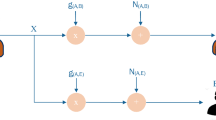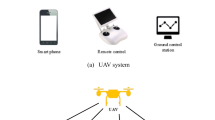Abstract
An unmanned aerial vehicle (UAV) relay network is a promising solution in the next-generation wireless networks due to its high capacity and unlimited geography. However, because of the openness of wireless channels and UAV mobility, it is remarkably challenging to guarantee the secure access of UAV relay. In this paper, we investigate the physical layer authentication (PLA) to verify the identity of the UAV relay for preventing unauthorized access to users’ information or network service. Unlike most existing PLA methods for UAV, the proposed PLA scheme fully considers the time-varying of physical layer attributes caused by UAV mobility, and transforms the authentication problem into recognizing nonlinearly separable physical layer data. Particularly, we propose a manifold learning-based PLA scheme that can authenticate the mobile UAV relay in real time by establishing the local correlation of physical layer attributes. The Markov chain of physical layer data in the time domain is established to evaluate UAV state transition probability through the proposed diffusion map algorithm. The legitimate UAV and spoofing attackers can always be authenticated by the different motion states. Performance analysis offered a comprehensive understanding of the proposed scheme. Extensive simulations confirm that the performance of the proposed scheme improves over 18% in resisting the intelligent spoofing UAV compared with the traditional methods.
Similar content being viewed by others
Explore related subjects
Discover the latest articles and news from researchers in related subjects, suggested using machine learning.References
Wang H, Zhao H, Zhang J, et al. Survey on unmanned aerial vehicle networks: a cyber physical system perspective. IEEE Commun Surv Tut, 2020, 22: 1027–1070
Li B, Fei Z, Zhang Y. UAV communications for 5G and beyond: recent advances and future trends. IEEE Internet Things J, 2019, 6: 2241–2263
Shi W, Li J, Cheng N, et al. Multi-drone 3-D trajectory planning and scheduling in drone-assisted radio access networks. IEEE Trans Veh Technol, 2019, 68: 8145–8158
Sun X, Ng D W K, Ding Z, et al. Physical layer security in UAV systems: challenges and opportunities. IEEE Wireless Commun, 2019, 26: 40–47
You X H, Wang C-X, Huang J, et al. Towards 6G wireless communication networks: vision, enabling technologies, and new paradigm shifts. Sci China Inf Sci, 2021, 64: 110301
Guo Y, Wu M, Tang K, et al. Covert spoofing algorithm of UAV based on GPS/INS-integrated navigation. IEEE Trans Veh Technol, 2019, 68: 6557–6564
Li B, Fei Z, Zhang Y, et al. Secure UAV communication networks over 5G. IEEE Wireless Commun, 2019, 26: 114–120
Bikos A N, Sklavos N. LTE/SAE security issues on 4G wireless networks. IEEE Secur Privacy, 2013, 11: 55–62
Jiang L, Chang X, Bai J, et al. Dependability analysis of 5G-AKA authentication service from server and user perspectives. IEEE Access, 2020, 8: 89562–89574
Zhang M X, Fang Y. Security analysis and enhancements of 3GPP authentication and key agreement protocol. IEEE Trans Wireless Commun, 2005, 4: 734–742
Wang H M, Zhang X, Jiang J C. UAV-involved wireless physical-layer secure communications: overview and research directions. IEEE Wireless Commun, 2019, 26: 32–39
Wang H M, Zhang X. UAV SECURE DOWNlink NOMA transmissions: a secure users oriented perspective. IEEE Trans Commun, 2020, 68: 5732–5746
Ji X S, Huang K Z, Jin L, et al. Overview of 5G security technology. Sci China Inf Sci, 2018, 61: 081301
Xiao L, Wan X, Han Z. PHY-layer authentication with multiple landmarks with reduced overhead. IEEE Trans Wireless Commun, 2018, 17: 1676–1687
Fang H, Wang X, Hanzo L. Learning-aided physical layer authentication as an intelligent process. IEEE Trans Commun, 2019, 67: 2260–2273
Liao R F, Wen H, Chen S, et al. Multiuser physical layer authentication in Internet of Things with data augmentation. IEEE Internet Things J, 2020, 7: 2077–2088
Abdelaziz A, Burton R, Barickman F, et al. Enhanced authentication based on angle of signal arrivals. IEEE Trans Veh Technol, 2019, 68: 4602–4614
Hou W, Wang X, Chouinard J Y, et al. Physical layer authentication for mobile systems with time-varying carrier frequency offsets. IEEE Trans Commun, 2014, 62: 1658–1667
Fu Q Y, Feng Y H, Wang H M, et al. Initial satellite access authentication based on Doppler frequency shift. IEEE Wireless Commun Lett, 2021, 10: 498–502
Huang K W, Wang H M. Combating the control signal spoofing attack in UAV systems. IEEE Trans Veh Technol, 2018, 67: 7769–7773
Hoang T M, Nguyen N M, Duong T Q. Detection of eavesdropping attack in UAV-aided wireless systems: unsupervised learning with one-class SVM and k-means clustering. IEEE Wireless Commun Lett, 2020, 9: 139–142
Wang H, Fang H, Wang X. Safeguarding cluster heads in UAV swarm using edge intelligence: linear discriminant analysis-based cross-layer authentication. IEEE Open J Commun Soc, 2021, 2: 1298–1309
Jiang C, Fang Y, Zhao P, et al. Intelligent UAV identity authentication and safety supervision based on behavior modeling and prediction. IEEE Trans Ind Inf, 2020, 16: 6652–6662
Wang H M, Zhang Y, Zhang X, et al. Secrecy and covert communications against UAV surveillance via multi-hop networks. IEEE Trans Commun, 2020, 68: 389–401
Song Q H, Zeng Y, Xu J, et al. A survey of prototype and experiment for UAV communications. Sci China Inf Sci, 2021, 64: 140301
Wang N, Jiang T, Lv S, et al. Physical-layer authentication based on extreme learning machine. IEEE Commun Lett, 2017, 21: 1557–1560
Pan F, Pang Z, Wen H, et al. Threshold-free physical layer authentication based on machine learning for industrial wireless CPS. IEEE Trans Ind Inf, 2019, 15: 6481–6491
Qiu X, Jiang T, Wu S, et al. Physical layer authentication enhancement using a Gaussian mixture model. IEEE Access, 2018, 6: 53583–53592
Ma Y, Fu Y. Manifold Learning Theory and Applications. Boca Raton: CRC Press, 2012
Olson C C, Judd K P, Nichols J M. Manifold learning techniques for unsupervised anomaly detection. Expert Syst Appl, 2018, 91: 374–385
Lindenbaum O, Salhov M, Yeredor A, et al. Gaussian bandwidth selection for manifold learning and classification. Data Min Knowl Disc, 2020, 34: 1676–1712
Mishne G, Cohen I. Multiscale anomaly detection using diffusion maps. IEEE J Sel Top Signal Process, 2013, 7: 111–123
Song Q, Zheng F C, Zeng Y, et al. Joint beamforming and power allocation for UAV-enabled full-duplex relay. IEEE Trans Veh Technol, 2019, 68: 1657–1671
Zeng Y, Zhang R, Lim T J. Throughput maximization for UAV-enabled mobile relaying systems. IEEE Trans Commun, 2016, 64: 4983–4996
Li N, Xia S D, Tao X F, et al. An area based physical layer authentication framework to detect spoofing attacks. Sci China Inf Sci, 2020, 63: 222302
Xia S, Tao X, Li N, et al. Multiple correlated attributes based physical layer authentication in wireless networks. IEEE Trans Veh Technol, 2021, 70: 1673–1687
Zhang S, Zhang H, He Q, et al. Joint trajectory and power optimization for UAV relay networks. IEEE Commun Lett, 2018, 22: 161–164
He X F, Dai H Y, Ning P. HMM-based malicious user detection for robust collaborative spectrum sensing. IEEE J Sel Areas Commun, 2013, 31: 2196–2208
Camastra F, Staiano A. Intrinsic dimension estimation: advances and open problems. Inf Sci, 2016, 328: 26–41
Lindenbaum O, Yeredor A, Salhov M, et al. Multi-view diffusion maps. Inf Fusion, 2020, 55: 127–149
Granata D, Carnevale V. Accurate estimation of the intrinsic dimension using graph distances: unraveling the geometric complexity of datasets. Sci Rep, 2016, 6: 31377
Erba V, Gherardi M, Rotondo P. Intrinsic dimension estimation for locally undersampled data. Sci Rep, 2019, 9: 17133
Mo D Y, Huang S H. Fractal-based intrinsic dimension estimation and its application in dimensionality reduction. IEEE Trans Knowl Data Eng, 2012, 24: 59–71
Singer A, Erban R, Kevrekidis I G, et al. Detecting intrinsic slow variables in stochastic dynamical systems by anisotropic diffusion maps. Proc Natl Acad Sci USA USA, 2009, 106: 16090–16095
Cayton L. Algorithms for Manifold Learning. Technical Report, University of California, San Diego, 2005, 12: 1–17
Khanduri R, Rattan S S. Performance comparison analysis between IEEE 802. 11a/b/g/n standards. Int J Comput Appl Tech, 2013, 78: 13–20
Acknowledgements
This work was supported by National Natural Science Foundation of China (Grant Nos. 61932005, 61941105), Shenzhen Science and Technology Innovation Commission Free Exploring Basic Research Project (Grant No. 2021Szvup008), and 111 Project of China (Grant No. B16006).
Author information
Authors and Affiliations
Corresponding author
Rights and permissions
About this article
Cite this article
Xia, S., Tao, X., Li, N. et al. Physical layer authentication in UAV-enabled relay networks based on manifold learning. Sci. China Inf. Sci. 65, 222302 (2022). https://doi.org/10.1007/s11432-021-3410-2
Received:
Revised:
Accepted:
Published:
DOI: https://doi.org/10.1007/s11432-021-3410-2




